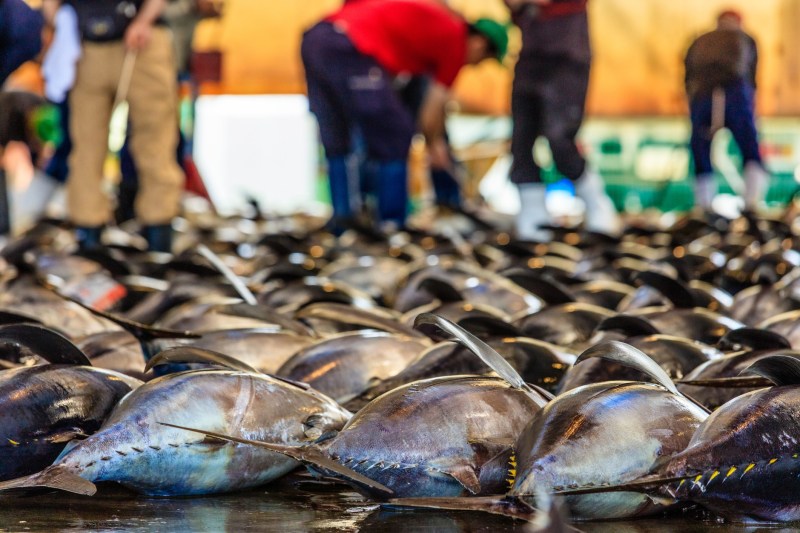
From nature to nutrition, the ocean and its wildlife play a vital role in our everyday lives. For us to continue to enjoy all this delicate ecosystem has to offer, we must take steps to protect and preserve it.
Related Guides
One of the simplest ways to have a positive impact on our natural waterways is by making sustainable choices when shopping for seafood. Purchasing fish and seafood that has been caught or farmed in ways that are minimally invasive or damaging to the ocean’s environment is the best way to ethically eat all of the fruits of the sea.
Knowing how to identify the most sustainable seafood does require a little bit of knowledge but these resources will make it easier to navigate these waters.
What Does Sustainability Mean?
Sustainable seafood is wild or farmed and harvested in an environmentally safe manner with the least amount of impact on the ocean ecosystems and surrounding wildlife.
The Monterey Bay Aquarium’s Seafood Watch Program is the standard for sustainability resources. Seafood Watch works with fishing industries around the world to ensure that seafood is produced in an ethical and environmentally responsible way.
Seafood Watch believes that environmental protection, social responsibility, and economic viability are the key to making sure the fisheries and aquaculture we rely on for food and livelihoods are healthy for humans and the ocean for years to come.
Seafood Watch also works to promote regulations like enforceable catch limits to prevent species from being exploited and overfished, and addresses illegal fishing and destructive harvesting methods like bycatch — the unintentional capture of other marine species such as dolphins and sea turtles in fishing nets.
Farming and Catch Methods
Wild Caught
Wild-caught seafood is harvested by fishermen in the fish’s natural habitats. While this method tends to produce the freshest, most nutritious fish with a lower environmental impact, wild fisheries have to make sure that the fish populations are not being overfished, and fishing gear that is used has the least impact on the surrounding habitats to ensure sustainability.
Farm-Raised
Farmed or Aquaculture fished seafood is commercially raised in controlled environments and was created as a way to produce lower cost seafood while also addressing the problems with overfishing wild-caught populations.
Farm-raised fish makes up about 90% of the fish consumption within the U.S. and in the past, the industry has faced many issues due to poor standards, genetic modifications, and pollution. However, governments and farmers have begun to regulate farmed fish and adopt healthier practices like reducing environmental damage, disease, and pollution, and limiting the use of wild fish as feed. Properly implemented, aquaculture can be a very sustainable seafood source.
Fish Aggregating Device
Any fishes caught using a fish aggregating device (FAD) should always be avoided. This method is typically used in tuna fishing, employs a giant net attached to the ocean floor to catch a wide group of animals, many of which shouldn’t be harvested, and causes devastating habitat damage. Many countries have moved to ban the use of FADs in commercial fishing.

Sustainable Shopping Tips
Local
Buying from local fisheries not only supports the local economy but involves seafood that is usually caught in more environmentally sustainable ways. Smaller fisheries use catch methods like handlines, pots, and traps or diving, which have a lower impact on the surrounding ecosystems.
Many of the fish in stores is farm-raised overseas and imported from countries with less sustainable regulations than the U.S. These fish can often contain high levels of antibiotics and chemicals that aren’t held to the same standards of sustainability and quality as the American fisheries.
Season
Like most foods, seasonality plays a huge part in their availability and sustainability. Since fish are migrating creatures, knowing what is in season in your area will guarantee you the freshest and eco-friendliest options.
Variety
The “Big 5” (Cod, Haddock, Tuna, Salmon, and Prawns) are the most consumed seafood in America and this high demand can lead to the issues of overfishing, harmful catch methods, habitat destruction, and overuse of antibiotics that we are now working to address.
Shopping for alternative seafood species — like rainbow trout, mullet, sardines, and mackerel — is a great way to get the same nutrients, expand your culinary palate, and encourage the sustainability of the fisheries by reducing the pressure on other species and allowing them to rebound.
Seafood Markets
Whether you are at the farmers market or a grocery store, buying from the fish counter is the best way to get the freshest seafood and the expert at the counter can usually direct you to the most sustainable options.
Stores like Whole Foods work with Seafood Watch to label their fish for sustainability and there is also an app from the Monterey Bay Aquarium Seafood Watch which can be used to identify fish they consider to be best choices or good alternatives and those you want to avoid.
Frozen Seafood
Shopping for previously frozen seafood is a healthy and affordable option that benefits from learning about the fish on the packaging.
Seafood labeled with a logo from the Marine Stewardship Council (MSC), Aquaculture Stewardship Council (ASC), or Best Aquaculture Practices (BAP) will identify that the seafood has come from an American or sustainable overseas fishery.
Stores like Whole Foods, Costco, Safeway, and Stop & Shop all have sustainable seafood brands.
Canned Fish
Tinned tuna fish will be labeled with the same sustainability logos as fresh and frozen. When shopping for tuna, it is important to note the “pole caught” harvesting methods to avoid products made from farming methods like FADS that can cause bycatch.
There are tuna brands like Safe Catch, Wild Planet, and American Tuna that are known for being sustainably caught.



